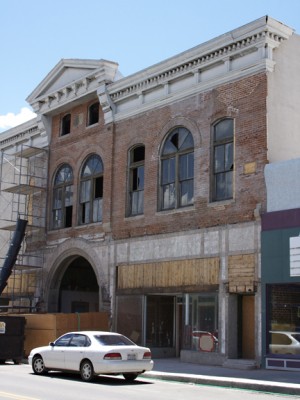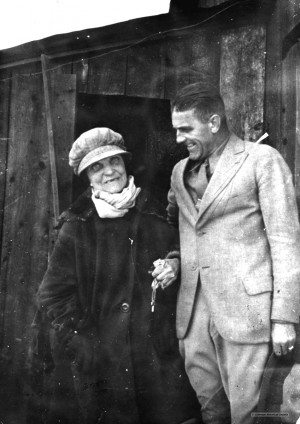by George Sibley
Next month – June 7 to be exact – there will be a water-related meeting in Salida that could be kind of historic if there’s a genuine effort to make it so. It’ll be a meeting of the Gunnison Basin Roundtable and the Arkansas Basin Roundtable. The purpose of the meeting is to see whether it’s possible to cut through the B.S. shielding a couple Colorado Water Cliches.
Cliche One: Urban growth just can’t be stopped, so it has to be accommodated.
Cliche Two: There has to be at least half a million acre-feet of Colorado River Water left for Colorado to develop.
This is just personal opinion, of course. And in the interest of full disclosure, I need to acknowledge that I am a member of the Gunnison Basin Roundtable. But I’m also an instigator in setting up this meeting, which I hope will muster the gumption and attempt to be historic, at least a little bit.
These Basin Roundtables are a relatively recent thing, created in 2005 by the state legislature in the Colorado Water for the 21st Century Act (HB 05-1177). This act created a Roundtable in each of Colorado’s eight major watersheds, plus a ninth for the “cultural sink” of the metropolitan area, and these Roundtables are legally bound to try to broaden the water discourse beyond the usual coterie of water lawyers, hydrological engineers, and other “water buffalo,” to include municipal and county officials, environmentalists, agricultural representatives, and other entities impacted by water decisions.
Each Roundtable has a dual charge under the law. First, to “know itself,” through a thorough analysis of its consumptive and non-consumptive water needs, now and into the future, and how those needs might be addressed. Second, to practice the Golden Rule with the Roundtables of other basins, treating them and their problems with the respect and dignity we each expect from the others for our own basin. That second charge was formalized in the creation of an Interbasin Compact Committee (IBCC), a body with representatives from each Basin Roundtable plus some other state-level appointees from the governor. They are charged with trying to help the Basin Roundtables work out mutual problems – presumably problems related to the desire of one basin to divert water from another, but no basins have mustered the gumption to try that process yet.
The Arkansas and Gunnison Basin Roundtables might be getting close to that, though. For the past quarter century, the Arkansas Basin has been experiencing a slow but steady loss of agricultural water to Colorado’s Front Range. This is mostly due to individual farmers in southeastern Colorado selling their private land and water rights (or just their water rights) to Aurora or some of the other fast-growing metro suburbs. In a land where private property rights are sacred, there is no way of preventing this, but as farms disappear from the landscape, the communities that served them begin to disappear too. Lawrence MacDonnell, a longtime student of Colorado water issues, wrote about this Arkansas Basin dilemma in his book, From Reclamation to Sustainability:
“What would it mean to have at least fifty thousand acre-feet less available (water) for irrigation use? What would it mean … for the cost of (the remaining farmers’) water? For the continued care of the canal? For the businesses in adjacent communities closely tied to irrigated agriculture (seed companies, farm-equipment suppliers, processors, shippers)? For the businesses that benefit more indirectly (hardware stores, clothes stores, supermarkets)? For the schools, roads, and other county services supported by property tax assessments?”
Front Range cities also take water out of the Upper Arkansas from above Buena Vista (although a lot of that is also brought into the Upper Arkansas from the Roaring Fork Valley). All of this attrition has caused the water leaders of the Arkansas Basin to look invidiously across the Divide at the Gunnison Basin, which so far has suffered no significant out-of-basin diversions.
Historically, that is a sore spot with the Arkansas Basin going back to the 1930s. The Bureau of Reclamation was then laying plans for a big transbasin diversion from Gunnison River tributaries into the Arkansas Basin for agricultural use in southeastern Colorado – a “mirror” project to the Bureau’s huge Colorado-Big Thompson Project diverting Upper Colorado River water into northeastern Colorado. But with West Slope Congressman Wayne Aspinall’s iron grip on the House Interior Committee, the Gunnison-Arkansas Project was gradually pared down to the Fryingpan-Arkansas Project, about one-fifth the size of the original plan, and taking nothing from the Gunnison Basin. Another effort in the late 1980s, the Union Park Project, to store and move water from the Gunnison’s tributaries to the Front Range basins, also failed when the water court – and ultimately the State Supreme Court – found there was not enough water available for such a project.
The cumulative effect of all these ancient and current tribulations led to a letter last summer from the Arkansas Basin Roundtable to the IBCC, asking, in effect, that the Gunnison Basin start sharing the burden of meeting the needs of the ever-growing Front Range cities.
At about that same time last summer, the “Big Six” metropolitan area water providers – Denver, Aurora, Colorado Springs, Pueblo, and the Northern Colorado Water Conservancy (Colorado-Big Thompson recipients) – also wrote a letter to the IBCC, complaining about its “laborious and largely unproductive” process of “identifying and prioritizing water supply and demand management alternatives to meet the Front Range water supply gap” (approximately 100,000 acre-feet by 2030 because you can’t stop urban growth). They did a summary analysis of both “water supply and demand management alternatives” that had been proposed by the IBCC. They noted that serious demand reduction beyond the 20 percent possible through conventional conservation would “necessitate major changes in land use, or significant alteration of the urban landscape” and get into “regulatory mechanisms” that have historically been considered off the table.
From their perspective, that left only the usual old alternative – to develop whatever “remaining unallocated component” of Colorado River water might be left on the west slope “in a manner that benefits future users of the resource on both sides of the Continental Divide within Colorado.” A “water supply alternative,” in other words, rather than a major “demand management alternative.” It goes without saying that the still-virginal Gunnison Basin would somehow be privileged to share in being “part of the solution” in that analysis (even though the State Water Engineer in 2002 declared that the Gunnison was already over-appropriated).
With both of those letters, the Gunnison Basin Roundtable decided to write a letter too – attempting to answer both the Arkansas Basin Roundtable letter and the one from the metropolitan water providers. The essence of the Gunnison Basin letter is that the real elephant in the room for Colorado is urban growth, most of which is in the Front Range. So long as that growth continues unchecked, the cities will continue to need more water from the non-urban and agricultural parts of the state.
That being the case, the Gunnison Basin letter went on to ask: isn’t it finally time for all of us – metro and non-metro entities alike – to start focusing on those heretofore unmentionable “major changes in land use, or significant alterations of the urban landscape” that might lead to major urban demand reduction? In other words, is it time to start requiring urban and suburban developments to “fit” into desert environments rather than continuing to allow them to deny environmental reality? The metropolitan area is not alone in building unrealistic cities. In fact, most of Colorado’s urbanized places – my hometown Gunnison, for example – are into the same kind of denial to some extent. But the metropolis is the only part of the state big enough and rich enough to be reaching out into the rest of the state with tunnels and pipes to continue watering that wet dream. If they are going to continue asking the non-urban places to endure the radical surgery of major water removal, shouldn’t they start practicing a little radical change as well?
Will we actually begin to talk about this at the June meeting? The Colorado Springs and Pueblo water providers are both in the Arkansas Basin, but also part of the metropolitan corridor, signers on the letter from the “Big Six” metro water providers. Will we all finally really start talking about Colorado’s real water problems, or will we all just be polite and agree that, yes, you just can’t stop growth? And never mind the ominously ambiguous findings of the Colorado River Water Availability Study – we all just know there’s another half million acre-feet for us there, right?
Stay tuned. Waterwise, either we’ll start making a little history early in this century – or we’ll just be history by the end of it …
George Sibley was born in Western Pennsylvania, but was conceived in Colorado by Colorado natives, and thus considers himself to be a native Coloradan.


